
When I was doing some research for a “Hope Clicks Eternal” Texans post, an image page brought the following program to my knowledge

I thought, “pretty cool old program”, so I set about researching the artist. That led to discovering a man named John Churchill Chase.

Born in New Orleans, Chase graduated from Isidore Newman School in 1922 (along with lifelong friend Charles “Pie” Dufour) and made his way to Chicago, where he attended the Chicago Academy of Fine Arts (now the School of the Art Institute of Chicago).
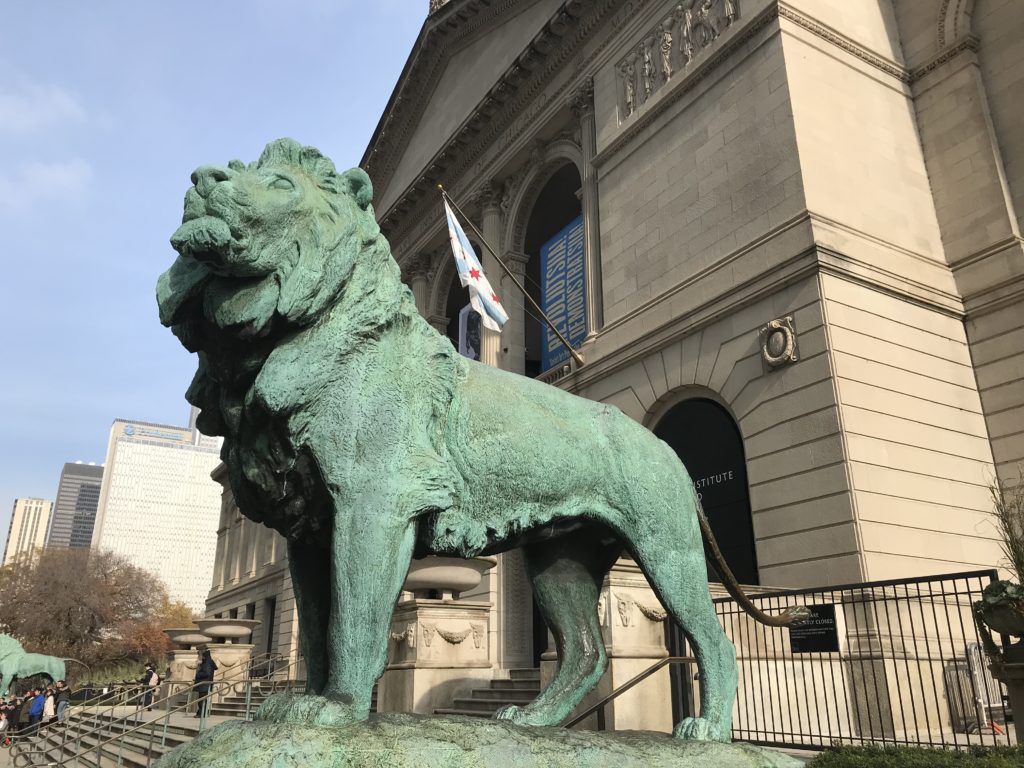
In Chicago, he worked at the Chicago Tribune with Frank King as an assistant cartoonist, becoming an assistant on projects like the famous “Gasoline Alley” comic strip.

As The Comics Journal says, “fondly catalogued as the first comic strip in which the characters aged, Gasoline Alley was created by Frank King in 1918 at the behest of Chicago Tribune publisher Colonel Robert McCormick, who wanted a feature that would appeal to people learning how to take care of their cars, which, thanks to Henry Ford, were becoming increasingly available to a middle class public.” McCormick felt that having a visual story which promoted the fascination people were developing for these newly mass-available inventions would drive readership. Turning it into more of a soap opera, it was thought, by having the characters age in somewhat real-time would keep readers loyal to the paper. As the strip went on, “King went on to convert everyday concerns about automobiles into a larger reflection of American life in a small town.”

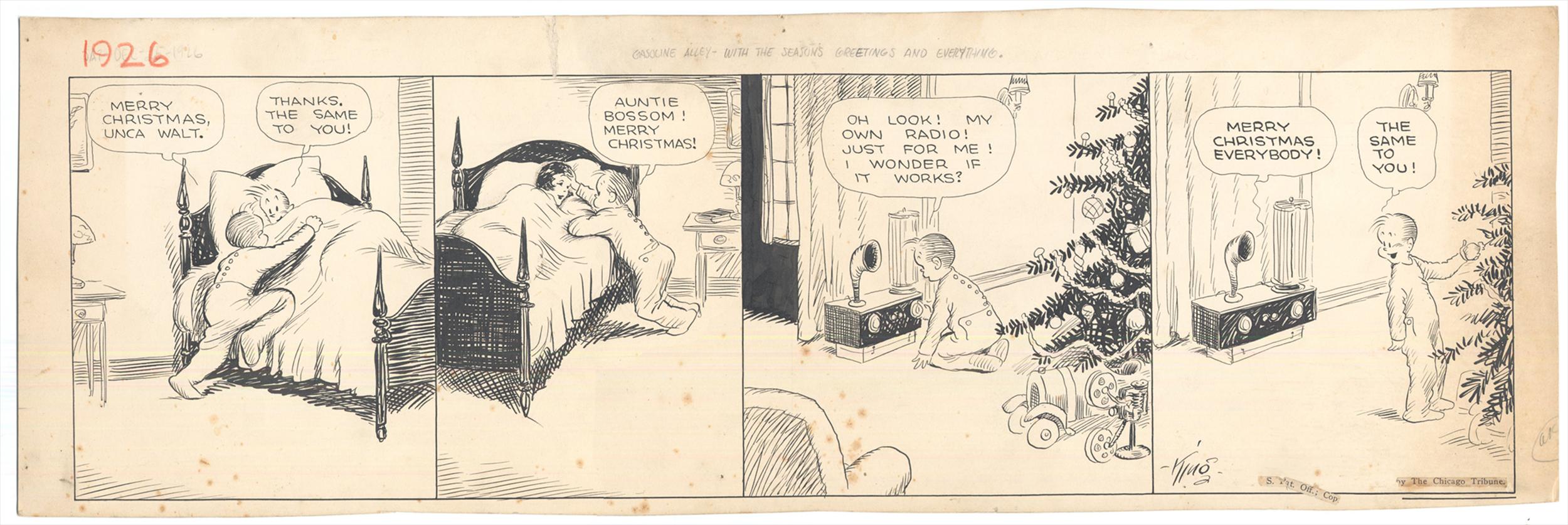
This was a huge influence on Chase, as he learned that readers will become invested in regular characters, especially “the little guy”, and that you could use those characters in non-traditional situations and trust peoples’ familiarity with them could help narrate part of the story being told in the panel.
Chase returned to NOLA in 1927, becoming the editorial cartoonist for the New Orleans Item, staying with the paper after its merger with the New Orleans Tribune in 1941. (The New Orleans Item-Tribune was bought by the owner of the New Orleans Times-Picayune in 1962, but continued to publish as a separate, afternoon daily paper until 1980, when both organizations were merged into one paper in 1980 and published under the Times-Picayune banner from 1986.) He remained chief editorial cartoonist until 1964.
[Just because I’m a History nerd, I read further into the name “Picayune”, because the term has always puzzled me, and this seemed like a good time to resolve it. According to Wikipedia, and verified on other sites (but I like Wikipedia’s explanation best), “The Picayune was established in 1837 by Francis Lumsden and George Wilkins Kendall. The paper’s initial price was one picayune, a Spanish coin equivalent to 6¼¢ (half a bit, or one-sixteenth of a dollar)”, ergo the name.]
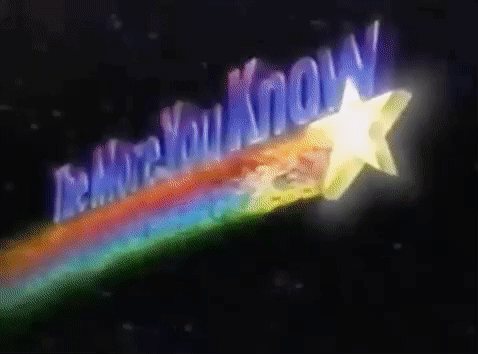
His most famous recurring character was known both as “The Little Man” and “Mr. New Orleans”. He looks a bit like a southern version of the Monopoly Man, albeit with an emphasis on a regular-guy wardrobe befitting his regular-guy stances on issues.
He also accepted people were fickle in their political opinions.


He was an economic conservative. Not a “if you’re poor, it’s your fault” prosperity gospel economic conservative like most people who claim to be conservative these days. He was more of a “take what you need, fix things that need fixing, and leave the rest alone” type of economic conservative.


His most famous work at the paper, however, wasn’t a cartoon. In 1935, after the assassination of Huey Long, the state police threatened to shoot any photographers & arrest any journalists who tried to enter the scene. Chase went to Baton Rouge and interviewed eyewitnesses. Their stories led him to draw a summation of the incident that was picked up by the AP and survives as the clearest account of what happened that day.

Beyond editorial cartoons, Chase was a sought-after artist for illustrating local events. For our purposes, that began when he was asked to draw the cover of the program for the 1938 Sugar Bowl, a game won 6-0 by Santa Clara.

[History lesson: Incidentally, this was only the fourth Sugar Bowl. It was first played in 1935, along with the Orange & Sun Bowls. (The oldest bowl game, or “Granddaddy” if you will, is the Rose Bowl, where a football game dates from 1902.)
In New Orleans, the idea of a New Year’s Day football game was first presented in 1927 by Colonel James M. Thomson, publisher of the New Orleans Item, Chase’s employer, and Sports Editor Fred Digby. Every fall thereafter Digby called for action, outlined a mid-winter calendar of sports, and even gave the proposed game its name – “Sugar Bowl.” The idea was first presented to the then-Southern Conference in 1929, but it was rejected. But that didn’t stop Digby from pursuing his dream.
In the interim, the New Orleans Mid-Winter Sports Association was created in early 1934, with one of its main goals being to land that desired football game. One of the keys was to raise $30000 to be put in escrow to cover the game’s expenses. Because they had financial backing , Tulane University allowed the promoters to use its 24000-seat stadium, which in turn then led the Southern Conference to approve the game.
When the Association met to choose participants, they selected Tulane, because they were both unbeaten on the season and hosting the game without charging a rental fee, and the Temple Owls, because they were the only undefeated team in the North. (Fun fact: Temple was coached by Glenn “Pop” Warner.) The game was a near-sellout – admission was $3.00 & $1.50, allowing each team to receive $27000 each as their split of gate receipts. Tulane won 20-14. Moreover, the game itself was a hit, and within two years the popularity of the game led Tulane to add 14000 seats to the stadium. In 1939, Sugar Bowl President Herbert Benson (uncle of 90 year-old, still-alive New Orleans Saints owner Tom Benson) led a municipal bond-issue to pay for expanding the stadium to over 70000 seats. The drive started in January 1939, and was fully financed by the end of March; construction started in June 1939 and was finished by December 1939, in time for the 1940 game.
To reflect the origins of the game, the Sugar Bowl’s Miller-Digby MVP trophy is partially named in game-founder Fred Digby’s honour.]
In 1945, Chase came up with “Greenie”, a mascot for the Tulane Green Wave football team.
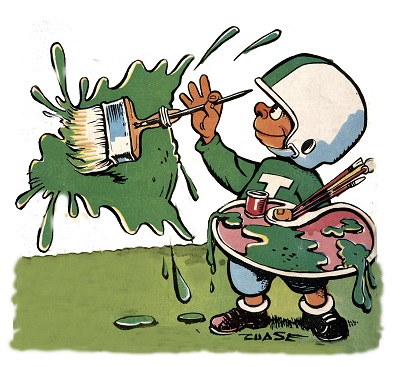

According to Tulane magazine, the idea for Greenie took influence from his editorial cartooning:
He decided against using the then typical “photograph of a pretty girl or a football player.” Instead, he created Greenie—a small, unostentatious character who wears an oversized helmet, a Tulane jersey and often carries a standard bearing the Green Wave logo.
On why being the little guy is noble, Chase said, “You automatically have the buyer’s sympathy then. Besides, it isn’t so bad when you lose.”
His work quickly became appreciated, since it gave the programs an individual feel, and Greenie became a mischievous part of the gameday experience and team identity. Chase would routinely work modern references into the work, giving the reader a current feel for the game by usually referencing past victories or slights.
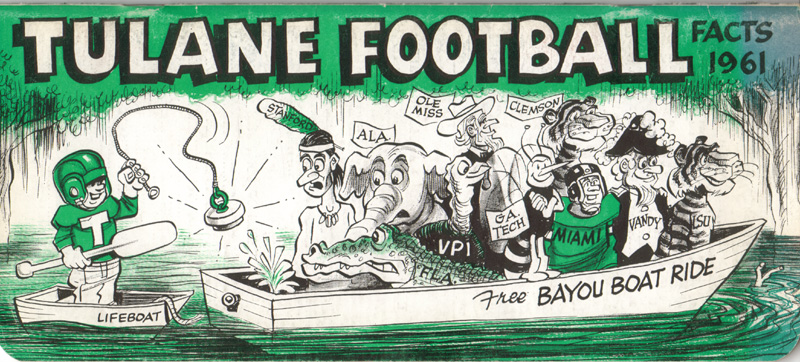
His work made the game programs collector items, much in the same way people collected Norman Rockwell Saturday Evening Post covers. His illustrations became an integral part of the Tulane football identity.


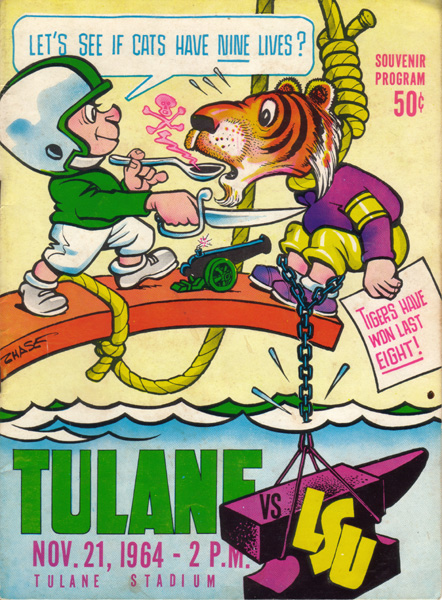
Over the years, his notoriety led to his being contracted by other schools to do pieces for their gameday programs, notably Rice University and the University of Texas. He drew for Tulane from 1945 until the late-1960’s, Rice from 1950 thru 1964, and for Texas from the mid 1950’s through 1966, practically inventing the look of “Bevo”, their ungular mascot.
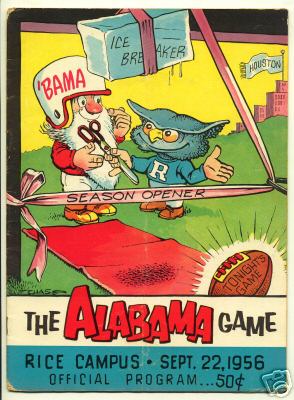
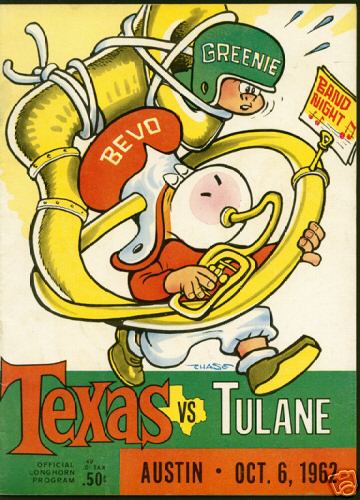
Greenie disappeared from Tulane’s repertoire in 1969, coincidentally, the same time as Chase stopped drawing the Tulane program covers, and “Riptide” the Green Wave, created in 1964, gained prominence. [Fun fact: The “Angry Wave” remained in existence until a new logo consisting of a white block “T” with green and blue waves crossing its center was adopted in 1986 as the primary symbol for official uniforms, though the “Angry Wave” cartoon continued to be used in licensed products. It became the primary athletic symbol and adorned Tulane uniforms through 1997.] Greenie was revived in 2014 as a football mascot, along with Riptide in 2016, when the university inaugurated their new Yulman Stadium, near the site of the old Tulane Stadium, returning Tulane football to the campus after 39 years in the Superdome.

Tomorrow – Part Two: John Churchill Chase and the NFL

I love when you get historical.
So we have Chase to thank for the knowledge that Huey Long was probably shot by his own bodyguards? Cool.
Holee shit! My father played football at Tulane in mid 40s after the Navy shipped him back from the Pacific. I have a dozen or so of his programs, many of them war themed. If I can remember to not be so lazy, I’ll photograph a few to share.
/speaking of Jimmy Stewart
“You’re not crying-I’m Crying!”
https://www.youtube.com/watch?v=mwGnCIdHQH0
The jazzy background music is jarring, strange and weirdly enticing.
/gonna watch “Anatomy of a Murder” for the first time
#GoBenGazzarra!
“Wow! Nicely done. And I thought ‘I’ was a deep diver.”
-Jacques Cousteau
It must be nice for Trent Brown to know that he’ll never be called for a holding penalty again.
http://www.nfl.com/news/story/0ap3000000929371/article/trent-brown-traded-by-49ers-to-new-england-patriots
So that sent me down a Huey Long rabbit hole. Turns out his assassin was killed by Long’s bodyguards, who shot him 61 times.
That’s a lot for a white guy.
Those are Cajuns. When they shoot a man they do it real spicy-like don’t matter what color
“Oh I love JCC’s work! I have all of his Sugar Bowl programs framed in my house!”
— Marc Trestman
I wish I was someplace warm and sunny. Those three Spring days were quite nice.
Wow! You must really work out!
His shoulders need some work, tho.
I do my best.
I wish we had old cartoony programs today. But we don’t.
Just cartoony people.
Wow, this was a fantastic article!
Damn, this was some good research.
Great stuff – thanks for the Picayune knowledge!
Also, was Greenie the inspiration for The Great Gazoo?
You bet.
As far as I can discern, Gazoo was simply a final-season Flintstones invention designed to introduce premises to keep the viewer through the remainder of their final episodes. (He appeared in 11 in total.)
Both Wikipedia & TV Tropes consider The Great Gazoo one of thefirst instances of “jumping the shark”, predating that actual episode by almost 20 years.
Hey, some of the Gazoo episodes were great! And also, how exactly does a cartoon about prehistoric suburbanites actually “jump the shark?” The episode where Gazoo creates clones of Fred and Barney so the boys can go bowling while the clones take the girls out to dinner is 1960’s television at its finest.
Right? Like, it’s no trouble to suspend disbelief for a talking dinosaur record player, but an invisible alien is just too far, man.
TOO FAR
I’m pretty sure Greenie was the inspiration for most of Major League Baseball, pre-steroids.
“I can’t remember the last time someone called me Greenie.”
-Trent Green